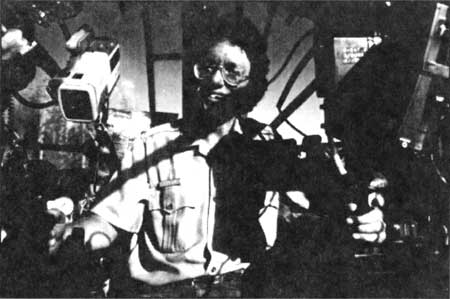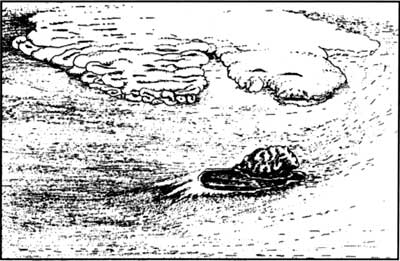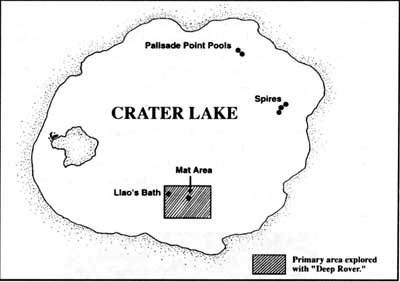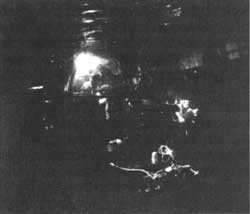|
Volume XXVII - 1996
Why enter a sleeping volcano in a submarine?
By Mark Buktenica
A summary of results and observations from hydrothermal,
biological, and geological submersible studies at Crater Lake National
Park, 1988-1989.
I was sitting alone in Crater Lake, 600 feet underwater in a
small submarine called Deep Rover. I had just completed collecting rock
samples along an underwater edge of Wizard Island, and I had 135 pounds
of rocks in a basket attached to the front of the submarine. Unknown to
me at the time, a couple of O-ring seals were leaking throughout the
dive. Water seeping through the seals into the submarine, combined with
condensation from my breathing, created an uncomfortable amount of water
on the floor. My feet were near the front of the vessel, and as I
prepared to start to the surface with the rocks, the submarine tilted
forward. As the submarine tipped, the water level at my feet rose
rapidly, giving the distinct impression that the submarine was filling
with water. Garbled and intermittent communications with the surface
crew aggravated the situation. Everyone operated expertly and
efficiently; Deep Rover and the rock samples were recovered smoothly.
Actual dangers and repairs turned out to be minimal, and the submarine
dove again the next day. Nonetheless, I thoroughly reviewed emergency
procedures at my first opportunity.
Crater Lake partially fills the caldera of the Mount Mazama Volcano
to an elevation of 6,172 feet. Once rising nearly a mile above the rim
of the caldera, Mount Mazama experienced a climactic eruption and
simultaneous collapse roughly 7,700 years ago. Crater Lake filled with
water to nearly its present level within a few hundred years of the
collapse. With a maximum depth of 1,932 feet, Crater Lake is the deepest
lake in the United States. The lake is well known for its deep blue
color and extreme water clarity, and visitors are amazed to see portions
of the lake bottom at water depths up to 115 feet on calm days.
Enabling legislation for Crater Lake National Park and the National
Park Service (NPS) allow for scientific study if there is no impairment
of natural resources. As the fifth oldest national park in the United
States, Crater Lake has a long tradition of hosting investigations aimed
at obtaining information about the physical, chemical, and biological
properties of the lake. Until 1982 lake research had to be done on a
sporadic basis, as funding and personnel would allow. Congress then
ordered the NPS to begin investigating Crater Lake in a more systematic
way, and by 1986 directed that the park's hydrothermal resources be
studied. A geothermal energy company was drilling exploratory wells
adjacent to the park boundary, evaluating the potential for geothermal
energy development, about the same time these requirements were passed.
Although the objectives of the park's hydrothermal studies were not
related to the drilling, undoubtedly this activity provided some
political impetus to fund the research. As a result, the one- person
submarine, Deep Rover, was flown into the caldera by helicopter
to conduct hydrothermal studies in 1988 and 1989. Simultaneously, other
studies, also using the submersible, were initiated to explore the
distribution of deep-water plants and animals and to assess the early
volcanic evolution and the postcaldera volcanic history of Mount
Mazama.

Author in Deep Rover submersible, photo by Mathis Von
Hesemans.
Operating a program that utilizes a submersible is a difficult
undertaking in the best of settings, but especially challenging in
remote areas at high altitude such as Crater Lake. The only access by
land to the lake was the steep, one mile-long Cleetwood Cove Trail.
Small four-wheel-drive tractors were the primary means of carrying
supplies and materials from the top of the caldera to the lake shore on
a daily basis. A base camp was established on Wizard Island and over
30,000 pounds of scientific and technical support equipment, including
the 7,000-pound Deep Rover, were flown to the island by
helicopter. The NPS insisted that no evidence of the operation remain on
the island or in the lake after we were done. Researchers were
meticulous in this regard and even transported dishwater out of the
caldera.
Deep Rover is a highly technical submarine that the NPS,
National Geographic Society, and U.S. Geological Survey leased from
Can-Dive, Inc., a company based in Vancouver, British Columbia. The
vessel is engineered for intuitive operation by its single occupant, who
must serve as pilot and scientist. The operator sits in a five inch
thick sphere of clear acrylic measuring six feet in diameter. This
sphere is attached to two battery pods, each containing ten 12- volt
marine batteries. The acrylic sphere opens at the bottom, like a clam
shell, allowing the scientist to enter and exit. Mechanical, electrical,
hydraulic, and life-support systems are mounted inside and outside of
the sphere. Two large manipulator arms are mounted on the front of the
submarine and are operated by the pilot inside. A basket mounted below
the manipulators is used to stow scientific samples. Cameras, sample
bottles, suction samplers, and sophisticated thermometers are other
examples of equipment attached to the submarine. Learning how to operate
Deep Rover required an intensive one-week training program that
included classroom instruction and field work in operation, safety, and
emergency response. This ensured that myself and two Oregon State
University Oceanographers, Dr. Jack Dymond and Dr. Robert Collier, were
ready by the time dives commenced in 1988.
Each dive day began with a trip to the dive site, which usually took
one or two hours. Deep Rover was towed behind a research boat in
a submersible "tender," designed specifically for use at Crater Lake.
Once all systems were judged to be functional, the operator crawled
through the narrow opening into Deep Rover, the submarine hull
was sealed, and all outside noise was suddenly muted. Upon being sealed
shut, Deep Rover heated up like a mini greenhouse, typically
reaching 92° F before descending into the lake un-tethered. With
permission to leave the surface, the pilot began the commute to the
bottom of Crater Lake.
I had the distinct privilege of conducting 17 dives in Deep
Rover. As I slowly sank into the depths of the lake, I was engulfed
in blue which eventually turned to darkness. The only sounds in the
submarine were the creaking and popping of the hull as it adjusted to
the increasing water pressure and the persistent hum of the carbon
dioxide scrubbers cleaning the air. The journey to the bottom could take
up to 30 minutes, during which time my personal fears were easily
extinguished by the intrigue and demands of the work. After reaching the
bottom on my dive to the deepest part of Crater Lake, I shut off the
scrubbers and instrument lights to better experience the solitude and
quiet, and to briefly reflect on being the first person to visit the
deepest part of the lake. After several moments, I looked up through the
clear acrylic hull and noticed that the dive flag mounted on top of the
submarine was visible, and silhouetted against a slightly lighter
background. At 1,932 feet in depth my eyes could detect the vague light
from the surface, a surprising testament to Crater Lake's incredible
clarity. Yet there was little time for introspection. With less than six
hours allowed per dive, I was fully occupied with monitoring electrical
and life-support systems, operating the submarine, collecting samples,
recording observations on tape and film, and communicating with the
surface boat via an underwater wireless telephone. Although the
submersible was designed to operate instinctively, many of the tasks I
had to perform required extreme concentration and were mentally
challenging, physically demanding, and sometimes frustrating.
Most of the lake floor is covered by fine sand colored sediments,
and operating the sub there was like flying at night over an uncharted
desert. One of the highlights of the research was discovery of bacteria
colonies associated with hydrothermal fluids deep in the lake. These
colonies form yellow-orange mats which appeared to hang on to or cascade
down sediment slopes and rock outcrops. The mats consist of thousands of
Gallionella and Leptothrix bacteria, which live on
chemicals (primarily reduced iron) in the hydrothermal fluids that
slowly enter Crater Lake through the lake sediments. It is unusual that
the chemical energy from the fluids allows the colonies to live in
darkness on the floor of the lake, independent of photosynthesis, since
that process energizes most biological communities on the planet.
Temperatures measured inside of the mats were as high as 68° F,
whereas ambient water temperature was 38° F. Chemical geothermometry
models suggest that source temperatures of 104 to 329° F would
account for observed water chemistry and temperatures at the
lake-sediment interface.
Another interesting discovery was the presence of discrete pools of
saline water on the lake floor that had a distinct blue color. The first
"blue pool" discovered was named Llao's Bath by Jack Dymond, after the
legendary spirit of the lake. The pool resembled an oblong bath, 10 to
13 feet long and 3 to 5 feet across. It appeared to be elevated on one
side by precipitates, and was surrounded by golden-colored bacteria.
This pool and others like it are composed of hydrothermal water with
salt content as much as ten times higher than the surrounding lake
water. The presence of the salts makes the liquid in the pool heavier
than lake water, and the pools appear blue because of the optical
properties of the chemically enriched fluids. In general, many chemical
indicators of hydrothermal origin were detected in fluids taken from the
pools. In the most anomalous pool fluids, manganese was enriched by as
much as a million times and Radon (222Rn) was enriched
100,000 times over typical lake values. Helium-3, perhaps the most
distinctive indicator of a magmatic heat source, was enriched 500 times
more than values for water in equilibrium with the atmosphere.

Llao's Bath and "brain" mat complex. Llao's Bath is
in the foreground.
Drawing by Kathryn Brooksforce.
We were surprised to find another area of hydrothermal activity
below the Palisades along the northeast caldera wall during one of the
dives. Small stream-like features originated from underneath boulders or
rock outcrops along the base of the caldera wall. The stream-like
channels were two to three inches in width and equally as deep. Although
no flow was observed at the time, the channels formed networks which
exhibited classic erosional flow patterns. The channels were lined with
brilliant gold bacteria and often terminated down slope in a series of
blue pools. Twenty or more pools with associated islands, embayments,
and delta-like features were observed in an area approximately 160 feet
wide and 320 feet long.
Along the base of the east wall below Skell Head, remnant spires
served as a record of past hydrothermal activity. Over 30 feet high, the
spires had a chemistry indicative of a hydrothermal origin and a
morphology consistent with underwater formation. Similar spires have
been observed around active, high-temperature, hydrothermal sources in
oceans around the world. The spires form when chemically rich
hydrothermal fluids come in contact with cold ambient water and the
chemicals precipitate out of solution to form chimneys around the
vents.
In addition to the hydrothermal studies, Deep Rover provided
a unique opportunity to survey the lake floor for plants and animals.
Previous biological studies of Crater Lake were limited to sampling from
a surface boat, collections along the shoreline, or shallow dives using
SCUBA gear. During the submersible studies, several unusual and
interesting biological discoveries were made. A thick band of moss,
Drepanocladus aduncus, encircled the lake, and was observed
growing at depths from 85 to 460 feet. It hung like icicles on vertical
cliffs and formed thick lush fields on the gentler slopes around Wizard
Island. The remarkable lower depth limit of 460 feet was due to the
ability of light to penetrate deep into Crater Lake's clear water.
Animals were found living in Crater Lake's deepest basin at 1,932
feet below the surface. This was particularly fascinating because of the
extreme water pressure that these animals must sustain to live at this
depth. The deep-water animals were found at relatively low densities and
included flatworms, nematodes, earthworms, copepods, ostracods, and the
midge fly Heterotrissocladius. Many specimens survived the rapid
pressure change during the retrieval from the lake floor and lived in
the laboratory for several weeks after collection.

The geological studies conducted with Deep Rover expanded our
knowledge of the eruptive history of Mount Mazama. Most of the rocks
sampled from the caldera walls were lava flows which came from Mount
Mazama, but a few samples collected from greater depth were rocks which
predate Mount Mazama. These studies also provided new information on
postcaldera volcanism by indicating which lava flows occurred beneath
lake water and which erupted before the lake filled. Flows that formed
the central platform, located east of Wizard Island, came about prior to
the lake level reaching them. Merriam Cone and most of the submerged
portion of Wizard Island formed beneath the water surface when the lake
was approximately 250 feet below its present level. All of the
postcaldera rocks sampled were andesite, with the exception of those
from a small rhyodacite dome on the east flank of Wizard Island. The
rhyodacite dome rises to approximately 100 feet of the lake surface and
may have formed when the lake was close to its present level. The dome
is the youngest volcanic feature known, with an age of approximately
5,000 years before present.
The dives were not without an element of mystery. I observed craters
with a diameter of two to three inches in the deepest part of the lake.
The origin of these craters is still unknown, though they may have
formed from biological activity or from processes associated with gas
and/or fluid release from the lake sediments. With so much to explore,
it was hard to accept that the voltage remaining in the submarine's main
batteries dictated the length of each dive. At the end of a typical
six-hour dive, the temperature of the submarine was a comfortable 68
°F. Tired but still operating on adrenalin, I stretched the length
of the dives out as long as possible. When the dive was over, air was
added to the submarine's ballast tank allowing Deep Rover to
slowly leave the lake floor. This was the first opportunity to relax
during a dive. The ascent into natural light was peaceful. As Deep
Rover rose and the water pressure decreased, air in the ballast tank
would expand and spill out the base of the submarine rising around the
sphere in a silvery blue veil of bubbles. Once on the surface, a crew of
scientists and technicians quickly descended upon the submersible to
secure and preserve the invaluable samples.
Deep Rover opened a brief and rare window of opportunity to
view and explore secrets hidden at the depths of Crater Lake, yet less
than two percent of the lake floor was explored. Discoveries from the
submersible program not only provided valuable information on lake
ecology and evolution important to understanding and protecting the
lake. The program also documented previously unrecorded lush fields of
moss, animals living at the bottom of the lake, and hydrothermal streams
and vivid blue pools that supported exotic gardens of yellow-gold
bacteria. The unusual scenes on the lake floor are consistent with the
aerial view that visitors experience today; a sight only slightly
altered from that which inspired people a century ago to dedicate
themselves toward the establishment of Crater Lake National Park.
The author would like to thank cooperative biological
investigators Gary L. Larson, C.D. McIntire, and Harry K Phinney,
principal geological investigator Charles R. Bacon, and principal
hydrothermal investigators Robert Collier and Jack Dymond. This program
would not have been successful without the tireless work of submersible
and scientific technical teams, and the staff of Crater Lake National
Park.

References
C.R. Bacon and M.A. Lamphere, "The geologic setting of Crater Lake,
Oregon," pp. 19-27 in E.T. Drake, et al. (eds.), Crater Lake: An
Ecosystem Study. San Francisco: Pacific Division, American
Association for the Advancement of Science, 1990.
R.W. Collier, et al. Studies of Hydrothermal Processes in Crater
Lake, Oregon. College of Oceanography Report #90 7. Corvallis, OR:
Oregon State University, 1991.
J. Dymond, et al. "Bacteria mats from Crater Lake, Oregon and their
relationship to possible deep-lake hydrothermal venting," Nature
342(1989), pp. 673-675.
C.D. Mclntire, et al. "Survey of deep-water benthic communities,"
pp. 661-679 in G.L. Larson, et al. (eds.), pp. 661-679 in G.L. Larson,
et al. (eds.), Crater Lake Limnological Studies Final Report.
Technical Report NPS/PNROSU/NRTR-93/ 03. Seattle: USDI, NPS, Pacific
Northwest Region, 1993.
C.H. Nelson, et al., "The volcanic, sedimentologic, and
paleolimnologic history of the Crater Lake caldera floor, Oregon:
Evidence for small caldera evolution," Geological Society of America
Bulletin 106(May 1994), pp. 684-704.
Mark Buktenica has worked at Crater Lake since 1985 and is
currently the park's aquatic ecologist.
|

